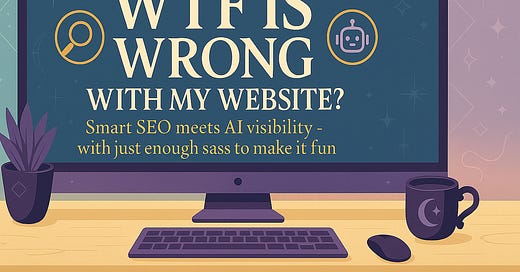Hey AI, WTF is Wrong with My Website?
Spot what’s breaking trust, flow, and SEO—and why AI might be skipping you.
We used to optimize websites mostly for Google’s traditional algorithm—crawlers, keywords, backlinks, meta tags. That’s still part of the picture. But now? AI is changing the game.
AI is often the first impression your business makes.
Before a human even visits your homepage, they may already have read:
A Google AI Overview summary, written by machine
A ChatGPT response that cites—or completely skips—your content
A Perplexity answer that links to competitors, but not you
If AI scans your content and… shrugs, you don’t just lose traffic—you lose credibility.
Traditional SEO ≠ AI Visibility
Google Search and AI-powered search tools are not playing the same game—so you can’t use the same playbook.
Traditional SEO (Google):
Google’s crawlers scan and index your site page-by-page, then rank those pages based on signals like:
Keywords & semantic relevance
Backlinks & domain authority
Mobile speed, metadata, and schema
Freshness and structured content
The goal? Serve up a list of links for users to choose from.
AI Search (LLMs like ChatGPT, Perplexity, SGE):
Large language models don’t just index your site—they read it, chunk it into digestible pieces, and summarize what they find.
They’re looking for:
Clear structure (headings, sections, logical flow)
Semantic clarity (not just keywords, but meaning)
Authoritativeness and topical consistency
Signals that match real user intent
The goal? Deliver a direct answer or summary—no click required.
TL;DR: Google wants to rank you. AI wants to explain you. If your content is too vague, inconsistent, or buried in fluff—AI bails.
The Real Issue? Your Site Isn’t Broken—It’s Confused.
Most websites technically “work.” They load. The links click. The images show up.
But beneath the surface, they’re sending mixed signals—to search engines, to AI tools, and most importantly, to your audience.
Here’s what that can look like:
Homepages that say everything except what you do (or who it’s for)
About pages that read like memoirs—full of backstory, short on trust
Services pages with no clear offer, pricing, or CTA
Blog posts that ramble without structure or alignment
Scattered branding—logo here, different tone there, chaos everywhere
Inconsistent messaging—“women founders” on the homepage, “SaaS case studies” in the portfolio
Conflicting metadata, missing alt text, or duplicated titles
Slow load times, broken links, and clunky mobile UX
Outdated plugin alerts or security warnings that quietly erode trust
Add AI search to the mix, and these gaps go from meh to fatal. Because now machines are scanning your site—and deciding if you're even worth mentioning.
Your AI-Ready Website Checklist (Preview)
Want to know if your website is sending strong, clear signals to AI and search engines?
Start with these 3 fixes:
Use Clean HTML — Don’t hide your key message in JavaScript
Keep Load Time Under 2 Seconds — Put the important stuff up top
Add Schema Markup — Help AI tools understand and quote your content
Grab the Full 10-Point AI Visibility Checklist → Get all 10 tips, with examples, prompts, and tools to test your site today. Find it here.
Why Does Structure Matter So Much Now?
You’ve seen the checklist. But here’s the deeper reason why it matters:
AI tools don’t just browse your site—they chunk it, analyze it, and quote from it. If your content isn’t clearly structured, they can’t pull what they need.
That’s where two powerful ideas come in: RAG and Fraggles.
What’s RAG & What’s a Fraggle?
If your site doesn’t show up in AI results, these two little acronyms are part of the reason:
RAG = Retrieval-Augmented Generation
It’s how AI tools like ChatGPT answer questions:
First, they retrieve useful content
Then, they generate a response in their own words
If your site is slow, messy, or unclear? It gets skipped during retrieval.
Fraggles = Fragments + Handles
Fraggles are bite-sized, quotable chunks of your content—like:
A list of benefits
A clear FAQ with answers
A how-to section with headings and steps
When your content is well-structured, AI can grab these fragments, quote them, and link directly to that part of the page.
Fraggles = Findable snippets AI loves to use.
WTF Is Wrong With My Website? The Fix Kit
Smart SEO meets AI visibility—with just enough sass to make it fun.
This isn’t another generic audit. It’s a self-guided clarity kit for business owners who are done guessing why their site isn’t getting seen, clicked, or trusted.
Inside, you’ll get:
A no-fluff PDF guide to spot what’s breaking trust, flow, and SEO
A custom GPT trained to help you fix your site like a pro (without needing to be one)
AI prompts, checklists, and real-talk advice on what bots really see when they crawl your site
If your site looks fine but isn’t pulling its weight, you’ll finally know why.
Join the early access list to get first dibs (and maybe test it early, if you're into that kind of thing).
You’ll be redirected to the System Mystic site to join the list. Same me—just my digital strategy & AI visibility HQ.
Final Thought for This Week
Most websites don’t need a total rebuild. They need clarity, digital coherence, and AI-ready content structure.
Because if AI can’t figure you out, your audience won’t either. Let’s fix that. I can help.
Stay curious, stay coherent ✨
Lisa
Resident System Mystic + Digital Detective at B Unlimited
Curator of Creating Smarter with AI





